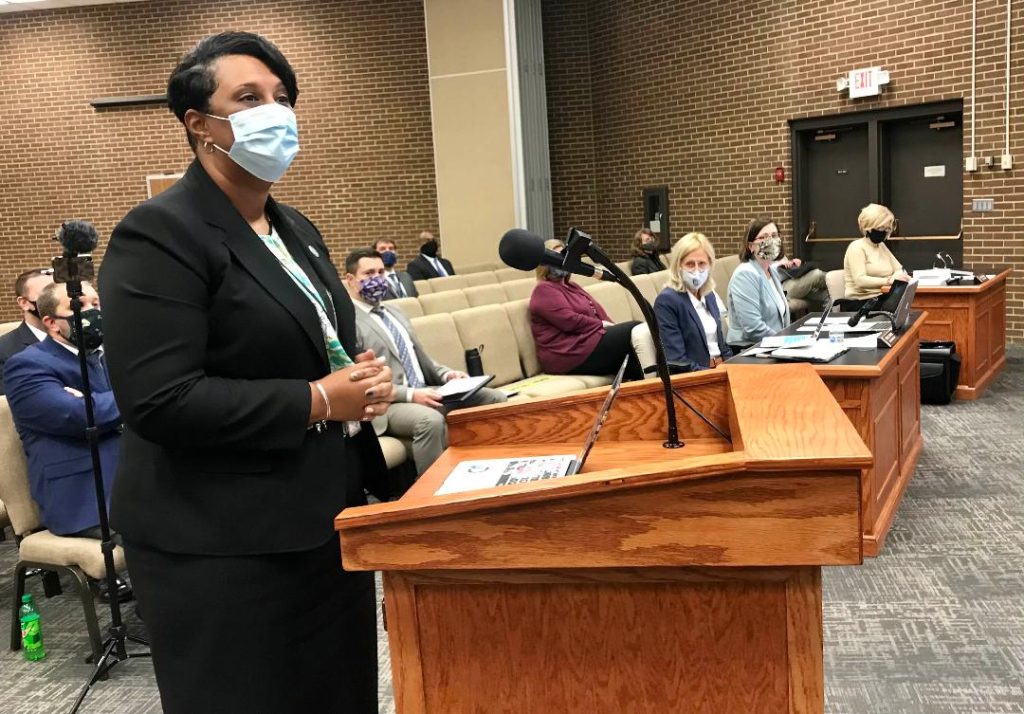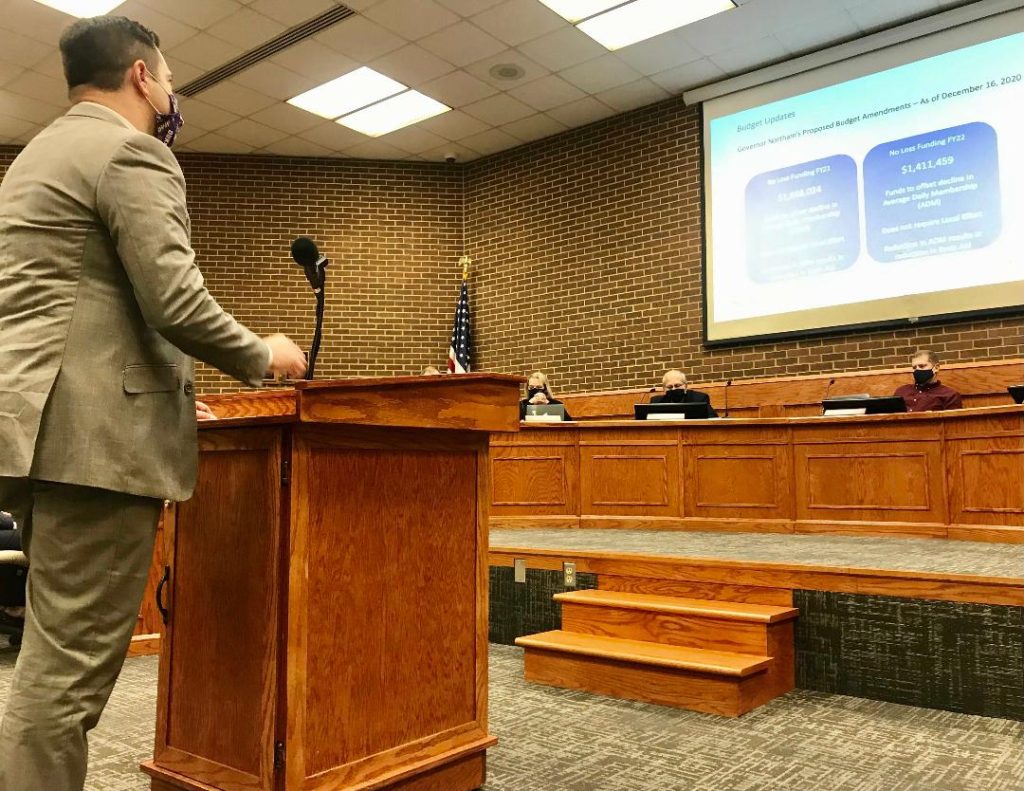
By Brandon Martin
Approximately a third of Henry County Public Schools students are failing at least one course, Lisa Millner, assistant superintendent of teaching and learning, said at a meeting Thursday.
“We have had some students that have done very well virtually. Unfortunately, during the first semester, some of our students have fallen behind in their coursework,” Millner said. “Some students are to the point that they are failing various courses.”
School officials plan to make up ground during the first week of the spring semester.
Based on a Jan. 4 report by the division, approximately 2,400 students of the 6,821 total were failing at least one course. Additionally, 1,759 students were failing two or more courses. In contrast, only 933 students were failing at this point in 2019.
Millner said of the students failing a course, about 1,394 primarily received instruction through the hybrid option, which includes in class and virtual learning options. The remaining 1,038 participated in completely virtual instruction.
The courses most failed were in core curriculum courses such as math, English, science, and social studies, according to officials.
“We have already met with principals and school counselors about student achievement data and various other instructional topics,” Millner said. “We discussed the spring semester we discussed the summer and we have also discussed the steps we are going to take for next year.”
When students return, Millner said the division would work in small groups for those who need additional assistance.
“Those small groups will be intentional,” she said. “They will be data driven and they will be flexible. The students will continue to be assessed and we will gather data for those students. In other words, they won’t go into one group and stay there. We will meet the needs for those students.”
Along with the small group instruction, Millner said that after-school tutoring groups will also begin in January, with “MHC After 3” currently offering virtual tutoring opportunities for secondary students. Some schools will offer a Saturday tutoring academy while others will implement ‘Homework Help Clubs.’
The division is also eying more summer school options, Millner said and added that summer school for elementary and middle school will be up to six weeks, with students attending Monday-Thursday, from 8 a.m. until noon. Transportation will be offered for those students.
Two sessions of recovery also are being planned for high school students.
“The thing that will be different is we are looking to provide transportation for those students as well,” she said. “This all depends on participation. We have to have student participation as well as teacher participation.”
Schools Superintendent Sandy Strayer said that the division historically has difficulty recruiting teachers to stay on for summer school and recovery programs.
“Our teachers work very, very hard all year long and many of them have commitments,” Strayer said. “They commit to us during the school year because they have a contract, but during the summer, they may have another job, or they may be taking classes. They have families, they don’t live here, and they make plans to travel. Over the years, we have found that a lot of the time our teachers cannot teach summer school.”
After conducting a survey of teachers at all levels, Millner said 48 teachers in elementary school have indicated interest in teaching over the summer, along with 26 teachers in middle school and 25 for high school.
As students return, the division will also work to gauge the social and emotional wellbeing of those in need.
“After some reflection, we decided to take a more grassroots approach and have our amazing group of school counselors generate those social and emotional questions,” said Matthew Woods, director of student support services. “We developed a large inventory of questions that can be used at all levels to make it more universal and applicable to our students. From there, we had several of the counselors volunteer to be a part of the Social and Emotional Task Force.”
So far, the task course has developed a “screener” to be used for identifying student needs.
“We’ve also developed the process for which that survey will go out, how it will be distributed and collected, but most importantly how that guidance will be provided to our schools to meet the needs of our students,” Woods said.
Monica Hatchett, director of communication, said that students will have support away from the schools as well.
“We are also collaborating with the United Way to create a community-based hotline for students who need to talk with someone about the stressors that the pandemic has brought to them,” Hatchett said. “This will be a supplement to what our counselors do during the day, but as we know, stress doesn’t stop for any of us. This community-based hotline will, in essence, take over for our counselors at night. This will be helping both students in our county and the city as well.”
Also, at the meeting, David Scott, assistant superintendent for operations and administrative services, provided an update on the school budget that incorporates Gov. Ralph Northam’s amendments.
“The no-loss funding is designed to offset any loss in average daily membership (enrollment),” Scott said. “As ADM goes down, that reduces our basic aid.”
Northam is currently proposing no-loss funding of $1,668,024 for fiscal year (FY) 2021.
“In the second year, it is about $1.4 million,” Scott said. “This is money that does not require local effort so that’s more or less un-equalized funding.”
Along with no-loss funding, Scott said another $715,508 will be available for at-risk students.
“This does require local effort to go with that and it also increases the amount of money per student in our preschool initiative by ($253,770),” he said. “That one is based on the number of students we get in there so there’s a potential for an increase.”

Scott said the most attention-grabbing portion of the budgetary amendments is the proposed two percent bonus.
“This is a lump sum set aside for (Standard of Quality)-funded positions,” he said. “The state does not require a local match on this per se. But that $601,052 that is sitting there, the way that is worded will basically require a substantially similar increase for all instructional and non-instructional positions to be paid out of local funds. It does commit us to cutting additional funds.”
As discussions among the budget committee continue, more decisions will be made on how to distribute the bonus.
“What will that two percent look like? Will that be added to annual compensation or paid as a one-time amount? As we continue to get our teachers and classified employees on step, we are going to incorporate that into a larger stepwise increase or percentage increase,” Scott added.
A public hearing on budget priorities will be held on Jan. 21 in the Summerlin Room of the Henry County Administration Building. The board is slated to approve the budget on March 4.
In other matters, the board:
*Elected Thomas Auker, of the Blackberry District, as chairman for 2021 and Francis Zehr, of the Ridgeway District, as vice chairman.
*Adopted the Virginia School Boards Association Code of Conduct for School Board Members.
*Approved Scott as the designee of the superintendent to attend meetings of the school board in case of the superintendent’s absence or inability to attend.
*Approved the 2021 meeting schedule. Regularly held meetings will take place on Feb. 4, March 4, April 8, May 6, June 3, July 1, July 22, Aug. 5, Sept. 2, Oct. 7, Nov. 4, Dec. 4, and Jan. 6, 2022.
*Recognized Principal Appreciation Week.
*Approved the 2021-2022 school calendar with a start date of Aug. 16.
*Approved the high school and middle school program studies.
*Appropriated $500,000 of unexpended school funds from the FY 2020 budget to cover the Transportation Garage Machinery Road project, renovations to the cafeteria at George Washington Carver Elementary School, and other items listed in the capital improvement plan.



